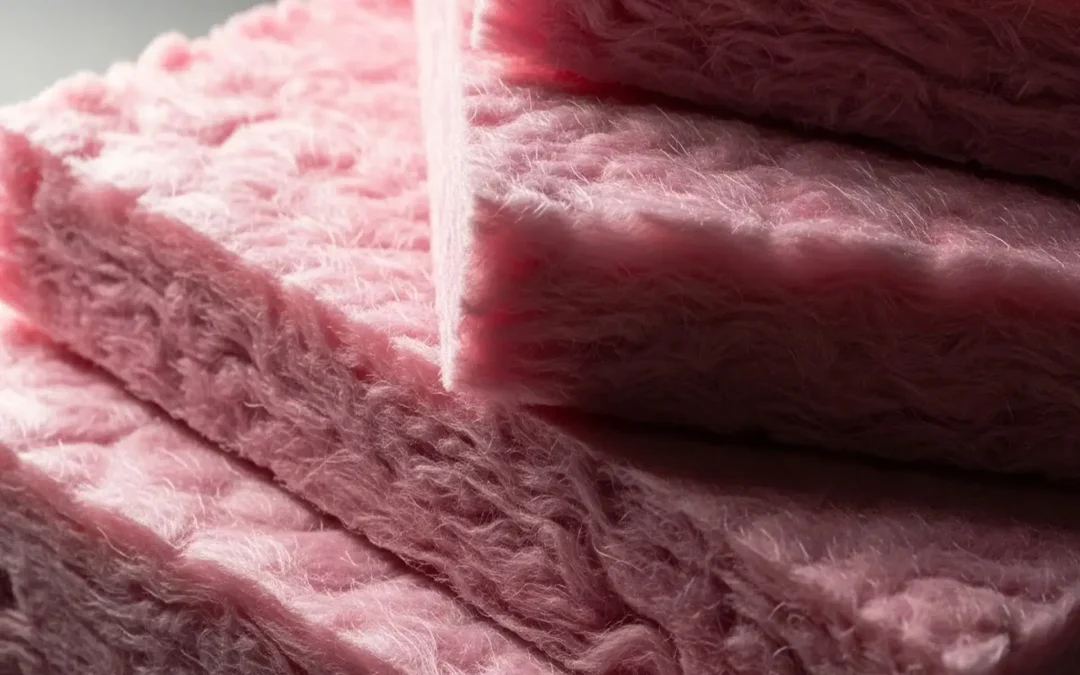Curious about fiberglass insulation thickness? Let me guess… You’ve got a project and you need to know how thick your insulation needs to be to get your house to stay warm and lower your energy bills. Well great! We’ve got you covered right here on this page.
For those who don’t know already, insulation thickness directly determines how warm, comfortable, and energy-efficient your home will be. In general, insulation works by slowing down heat transfer, and the thicker it is, the more protection it provides. The right thickness prevents heat loss in the winter, blocks excess heat in the summer, and reduces the amount of work your HVAC system needs to warm or cool the house year-round.
This guide walks you through everything you need to know about fiberglass insulation thickness: how it affects R-value, which thickness is right for your climate zone, and what professionals look for when installing insulation correctly. With the right R-value in the right areas of your home, you can dramatically improve comfort and reduce long-term energy costs.
Get an Insulation Assessment for Your Home!
What Is Fiberglass Insulation and How Does Thickness Affect R-Value?
Fiberglass insulation is one of the most widely used home insulation materials, available in batts, rolls, and blown-in loose-fill. It’s made from fine glass fibers that trap air pockets, creating a thermal barrier that resists heat movement through your walls, ceilings, and floors.
Thickness plays a major role in performance. As fiberglass insulation becomes thicker, its R-value increases, meaning it provides stronger thermal resistance and better protection against heat flow. Standard fiberglass batts achieve their R-value based on both thickness and density, while high-density batts offer more thermal resistance in a thinner profile.
Understanding the relationship between insulation thickness, R-value, and your home’s building envelope helps ensure you get the full benefits: reduced heat loss, lower energy bills, improved indoor comfort, and fewer drafts. Choosing the right thickness also prevents problems such as compression, air leakage, and uneven thermal coverage.
Not Sure What Thickness to Use to Maximize Comfort and Efficiency for Your Home? Contact Us for a Free Opinion Now!
Fiberglass Insulation Thickness by R-Value
| R-Value | Standard Thickness | High-Density Thickness | Common Applications |
|---|---|---|---|
| R13 | ~3½ inches | N/A | Standard 2×4 wall cavities |
| R15 | ~3½ inches (high-density) | N/A | High-density option for 2×4 walls; better performance than R13 |
| R19 | ~6¼ inches | ~5¼ to 6 inches | Older home exterior walls, floors above crawl spaces, basement walls, rim/band joists |
| R21 | ~5½ inches (high-density) | N/A | High-performance insulation for 2×6 exterior walls |
| R30 | ~9½ to 10 inches | ~8¼ inches | Attics, cathedral ceilings, and homes in colder climates (NY/Long Island Zones 4/5) |
What This Table Tells You
This table shows how insulation thickness changes depending on the R-value and whether you choose standard density or high-density fiberglass batts. Higher R-values generally mean thicker material, but high-density versions compress that performance into a slightly thinner profile.
R19
- Standard: ~6¼ inches
- High-Density: ~5¼ to 6 inches
- Use Cases: exterior walls in older homes, floors above crawl spaces, basement walls, rim/band joists
- Why it’s Used: Offers strong thermal resistance when space is limited.
R30
- Standard: ~9½ to 10 inches
- High-Density: ~8¼ inches
- Best for: attics in cold climates, cathedral ceilings, and homes in NY/Long Island
- Why it Matters: One of the most effective upgrades for winter comfort and reducing heating costs.
R13, R15, R21
- R13: ~3½ inches — standard for 2×4 walls
- R15: ~3½ inches but denser — better performance in the same cavity
- R21: ~5½ inches — ideal for high-performance 2×6 exterior walls
Together, these values help homeowners and contractors select the right insulation thickness for walls, ceilings, attics, and crawl spaces based on both cavity depth and desired thermal performance.
Why Thickness Can Vary by Manufacturer?
Different brands use different fiber densities and manufacturing techniques, which results in slight variations in thickness. High-density batts achieve a higher R-value in less space, while standard batts rely more on thickness.
One key rule: Insulation should never be compressed. When fiberglass is squeezed into a tighter space than it was designed for, its air pockets collapse, lowering the actual R-value and reducing energy efficiency.
Make Sure You’re Installing the Right Thickness.
How to Choose the Right R-Value for Your Climate Zone
Insulation requirements depend heavily on where you live. The U.S. is divided into eight climate zones, with colder zones requiring higher R-values for proper protection against heat loss. Most of New York, including Long Island, Queens, Brooklyn, and much of the Northeast, falls into Climate Zone 4, with some northern counties falling into Zone 5.
Homes in these zones need stronger insulation to handle long winters and temperature swings.
Recommended R-Values for New York Homes
Use these R-value standards as a guide for proper thermal protection:
| Home Area | Zone 4 (Long Island/NYC) | Zone 5 (Upstate NY) |
|---|---|---|
| Attic | R38–R49 | R49–R60 |
| Exterior Walls | R13–R21 | R19–R21 |
| Knee Walls | R19–R30 | R30 |
| Floors Above Crawl Spaces | R19–R30 | R30 |
| Basement Walls | R10–R15 | R15+ |
Why Older Homes Need Higher R-Values
Many homes built before the 1990s have far less insulation than today’s standards. Upgrading to the right R-value:
- Eliminates drafts
- Reduces monthly utility bills
- Prevents mold and moisture issues
- Improves HVAC efficiency
- Enhances overall comfort year-round
By matching insulation thickness to your climate zone, you ensure your home is properly protected from seasonal weather changes, especially in coastal and cold environments like New York.
Get a Free Expert Assessment for Your Long Island Property!
Common Mistakes When Choosing Fiberglass Thickness
Choosing insulation isn’t as simple as picking a batt and placing it in a cavity. Homeowners often overlook small details that dramatically impact performance, and these mistakes can lead to higher heating bills, cold rooms, and even moisture damage.
Common Issues to Watch For
- Using Insulation That’s Too Thin: Thin insulation underperforms, allowing heat to escape and increasing energy costs.
- Compressing Batts Into Narrow Bays: Compression collapses air pockets, reducing the actual R-value and creating uneven coverage.
- Installing New Insulation Over Old or Damp Insulation: Moist or compacted insulation traps humidity, promotes mold growth, and reduces effectiveness.
- Not Sealing Air Leaks First: Even the thickest insulation fails when air gaps allow heat to pass through unsupported spaces.
- Choosing R-Values That Don’t Match New York Winters: Installing an R-value meant for a warmer zone leaves the home cold and increases HVAC strain.
Each of these mistakes ultimately leads to wasted money, higher monthly bills, and potential moisture issues, especially in humid or coastal areas.
Avoid Costly Mistakes! Get Professional Guidance Now by Reaching Out Now!
Professional vs. DIY Installation: What Homeowners Should Know
Even the best insulation fails when installed incorrectly. Proper thickness, placement, and preparation are essential for achieving the insulation’s full rated performance.
Why Professional Installation Matters
Fiberglass must be installed at the full intended thickness to reach its rated R-value. Gaps, voids, or compression can reduce real-world performance by 30% or more—a common issue with DIY installs.
Common DIY Oversights
- Skipping critical air sealing before installation
- Blocking or covering ventilation pathways
- Incorrect or missing vapor barriers
- Covering soffit vents, restricting airflow
- Cutting insulation incorrectly, leaving gaps
Professionals understand how the building envelope works and ensure insulation performs as intended.
Zavza Seal’s in-house specialists follow strict installation standards to lock in full thermal resistance, prevent drafts, and improve long-term comfort.
Get Professional Insulation Installation Now!
How We Can Help: Our Home Insulation Solutions
Our insulation services are built to deliver long-term comfort, lower energy bills, and stronger home performance, tailored specifically to New York and Long Island’s demanding climate. We offer a full range of high-performance insulation options, including:
- Fiberglass Insulation: Fiberglass insulation is a reliable, cost-effective thermal protection for attics, walls, and floors.
- Blown-In Cellulose: Blown-in cellulose is a dense, eco-friendly insulation that reduces air gaps and improves sound control.
- Spray Foam: Spray foam insulation` expands to air-seal large areas, excellent for sound damping and moisture-prone spaces.
Each option is installed to meet or exceed recommended R-values for homes in New York’s Climate Zones 4 and 5, ensuring your home stays comfortable year-round while maximizing energy efficiency and long-term savings.
Why Homeowners Trust Us
- Licensed & Insured
- Full in-house insulation crews
- Fast Turnaround and Clean Installations
- Transparent, Upfront Pricing
- 5-star Reviews on Google Maps
Upgrade Your Home With the Right Insulation Thickness Today.
Cost Factors for Fiberglass Insulation Upgrades
The cost of an insulation upgrade varies based on the type and thickness of insulation needed, and the condition of your existing home structure.
What Affects the Price?
- R-Value Required: Higher R-values require more material or higher-density batts.
- Insulation Thickness: Thicker products cost more but deliver better long-term efficiency.
- Square Footage: Larger spaces require more material and labor.
- Existing Insulation: Removing old insulation or adding over older layers changes cost.
- Accessibility: Tight crawl spaces, high attics, and knee walls take longer to insulate.
- Density Type: High-density batts are more expensive but provide superior thermal resistance.
While prices vary, insulation upgrades typically pay for themselves through reduced energy bills and improved comfort, especially in New York’s long heating seasons.
Request a Customized Insulation Quote.
Fiberglass Insulation Thickness: Final Thoughts
Choosing the right insulation thickness is the key to keeping your home warm, energy-efficient, and protected from moisture. By matching the correct R-value to your climate zone and ensuring proper installation, you can improve comfort, reduce drafts, lower utility bills, and protect your home for years to come.
With Zavza Seal, you get precise sizing, expert installation, and comprehensive insulation assessments designed for New York’s climate.
Choose the Right R-Value and Upgrade Your Home’s Energy Efficiency Today
Frequently Asked Questions About Fiberglass Insulation Thickness:
Is Thicker Insulation Always Better?
Not always. The right thickness depends on your climate zone and the space you’re insulating. Too much thickness can also cause improper fit or compression.
What R-Value Do I Need in New York?
Most homes in Long Island and NYC require R38-R49 in the attic and R13–R21 in exterior walls, depending on construction and climate zone.
Can You Mix Insulation Thicknesses?
Yes, but only when moisture, airflow, and compression are properly managed. Professional guidance is essential.
Is R19 Enough for Exterior Walls?
For 2×6 walls, R19 or R21 is common. For 2×4 walls, R13 or R15 high-density batts are more appropriate.
What’s the Best Attic R-Value for Long Island?
R38–R49 is ideal to handle long winters, high humidity, and rising energy costs.








